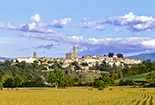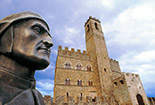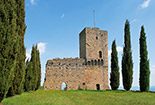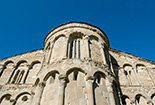Saint Fedele Abbey
in Casentino, a Tuscan valley with which you can get familiar in every detail through this site
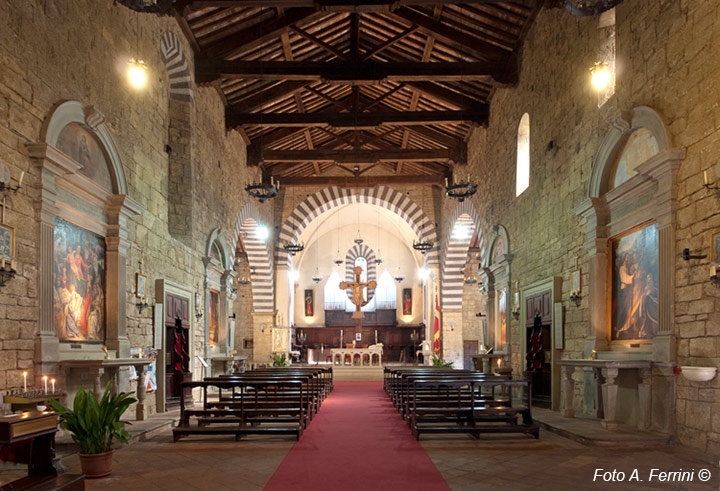
Texts and photos by Alessandro Ferrini ©
37 accurately described images of San Fedele Abbey. Click to enlarge
Badia San Fedele, monks from Vallombrosa in Poppi
 Badia San Fedele is located in Poppi, and it is one of the most interesting buildings of Casentino from a historical and architectural point of view and because of the painted works kept here. The church has a characteristic spiritual value for the inhabitants of this area because it is connected to the figure of Beato Torello, a Saint for the people of Poppi and a patron for this village of Casentino, whose remains are conserved inside the evocative Romanesque crypt of Badia San Fedele.
Badia San Fedele is located in Poppi, and it is one of the most interesting buildings of Casentino from a historical and architectural point of view and because of the painted works kept here. The church has a characteristic spiritual value for the inhabitants of this area because it is connected to the figure of Beato Torello, a Saint for the people of Poppi and a patron for this village of Casentino, whose remains are conserved inside the evocative Romanesque crypt of Badia San Fedele.
San Fedele Abbey, clearly noticeable in the landscape of Poppi, with very old origins: the Benedictine Abbey of Strumi, around three kilometers away from Poppi, founded at the end of the 10th century "pro remedio animae" by Count Tegrimo from the Guidi family, was the original nucleus of Badia San Fedele. During the 11th century the Abbey adopted the Rule of Vallombrosa; at the end of the 12th century, to satisfy the wishes of the Counts Guidi, it was moved inside the town walls of Poppi. The construction of the building lasted for several decades of the 13th century; the construction of the castle simultaneously took place, which became the main residence of the Guidi in Casentino. San Fedele Abbey, which had already been provided with substantial assets while being in Strumi, in the years to come was beneficiary of several donations by the Guidi, who in fact were buried here untill 1568, year in which the sumptuous sepulchre that was located in the presbytery was dismantled because of Abbot Andrea 3rd of Gaiole in Chianti's order, and therefore employing Pope Pio 5th's decree that prohibited burying above ground in churches. Counts Guidi's bones were buried near the sacristy, where a commemorative plaque honors this event. In 1810 the abbey was suppressed by the Napoleonic administration.
San Fedele abbey complex is located at the far north end of the village of Poppi, attached to the town walls (from which one of its towers the belfry was probably obtained) and in correspondence to the San Fedele City-Door (which, in fact, carries the same name of the abbey); the facade, with its gate dominated by a rose window, points towards west and faces a little piazza; however, the commonly used entrance is the one  on the side constituted by a portal opened in 1564, which nowadays presents the aspect that engineer Giuseppe Castellucci, who took care of the restoration of the Abbey between 1930 and 1933, wanted to give it. The project gave its original and strict Romanesque appearance back to the church by restoring the narrow windows, removing the Baroque decorations and partially closing the wide glass windows that had been opened.
on the side constituted by a portal opened in 1564, which nowadays presents the aspect that engineer Giuseppe Castellucci, who took care of the restoration of the Abbey between 1930 and 1933, wanted to give it. The project gave its original and strict Romanesque appearance back to the church by restoring the narrow windows, removing the Baroque decorations and partially closing the wide glass windows that had been opened.
The inside of the Abbey has the characteristics of the typical Latin-cross buildings of Vallombrosa with their transepts divided in three wide rectangular chapels. The triumphal arch of the apse and the two of the lateral chapels are stressed with black and white coloured bands, a theme that can also be found in the three windows of the apse, in the oculi of the walls, and in the arches of the underlying crypt. The high altar was made by a local sculptor following Castellucci's drawing. Luckily, during the restoration works, the Mannerist altars, which include fine paintings that had been created between the 13th and 17th century, were conserved.



